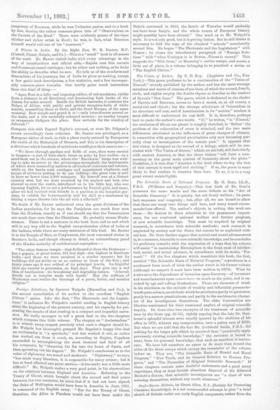The Vision of Esther. By C. D. Key. (Appleton and
Co., New York.)—This poem professes to be a continuation of the " Vision of Nimrod," already published by the autber, and has the same strange structure and metre of stanzas of ten lines, of which the second, fourth, sixth, and eighth employ the double rhyme so familiar to the readers of Byrou's "Don Juan." The poem, which is dedicated to the shades of Darwin and Emerson, seems to have a moral, or, at all events, a social end and object ; but the strange admixture of Orientalism in its structure and cast, and of Americanism in its "motive," renders it most difficult to understand its real drift. It is, therefore, perhaps
best to quote the author's own words. If," he writes, "in 'Nimrod,' the evolution of life on our planet is roughly sketched, in Esther' the problem of the colouration of races is attacked, and the two main differences attributed to the influences of great changes of climate, in connection with geographical peculiarities only now becoming par- tially clear to investigators of the remote past." It appears that this vision is designed as the second of a trilogy, wheel will be con- 'eluded with The Vision of Abram," which, we are told, will deal chiefly with ancient America, so that the three visions "will form a com- mentary on the great main current of humanity about the globe." Doubtless, it is true that "America is the lend where to.day the flow of that current is most rapid and striking." If so, the poem is more likely to find readers in America than hero. To us, it is to a very great extent unintelligible.






































 Previous page
Previous page